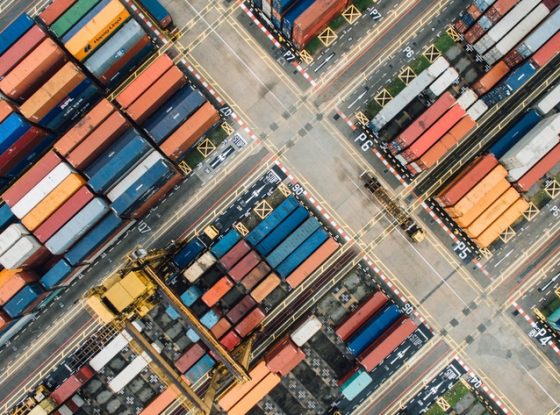Smart Supply Chain Management: 4 Game-Changing IoT Applications

Supply chain management (SCM) plays a vital role in every industry; directly contributing to a company’s success and overall customer satisfaction. In previous years, international trade disputes and natural disasters have disrupted supply chain management. These disruptions make a substantial impact – the outcome is expensive at best and catastrophic at worst. They affect a company’s ability to deliver product and drive revenue, and they can easily cause long-lasting brand damage.
COVID-19 has caused another unprecedented setback to supply chain management. 94% of the Fortune 1000 have reported experiencing coronavirus supply chain disruptions. This has created an even more complex challenge as supply chains have become a vital lifeline for distributing essential medical supplies, food and other key necessities where they’re needed most. Not to mention, with the massive shift to e-commerce, retailers are faced with an overwhelming production and delivery process to ensure a seamless online shopping experience.
Challenges in Supply Chain Management
The entire supply chain management process is complex. It involves coordinating across various disbursed, and commonly disconnected supply chain actors like producers, brokers, transporters, processors, retailers, wholesalers, and of course consumers. It often relies on outdated and manual processes to control and monitor a product’s flow from the procurement of raw materials and parts from the beginning of production through delivery to the consumer.
Monitoring and controlling the people, processes, parts and products as they transit through the SCM lifecycle is crucial in order to ensure efficiency, a strong reputation, and increased ROI. Despite the availability of several technological solutions, many companies still lack end to end visibility of their entire supply chain. A supply chain market report says that 63% of organizations have no tech systems in place for monitoring supply chain performance and 46% of supply chain professionals still rely on excel spreadsheets for their operations. This leads to inefficiencies such as missed key dates and milestones, contract lifecycle bottlenecks, issues with tracking deliverables, duplicate orders, failure to place orders and missed payments.
The pandemic has tested the resilience and flexibility of supply chain leaders globally and has highlighted the critical need for a system that is more robust, transparent, agile, and sustainable – but above all, digitally enabled. The Internet of Things (IoT) with new sensor and communications technologies is on the rise towards restructuring the entire process. The power of IoT lies in its ability to continuously monitor, assess and optimize real-time data on all people, processes, and things to provide unprecedented visibility into every process and transaction within the supply chain.
The Role of IoT in Smart Supply Chain Management
1. On-Road Asset Tracking
Supply chains have been transformed beyond recognition over the last year. Curbside pickup, BOPIS (Buy Online, Pickup in Store), shipments to neighbors, smart lockers, as well as direct to consumer (D2C) deliveries by manufacturers have become commonplace. Even perishable goods are in high demand with the advancement of more robust cold chains solutions for categories ranging from pharmaceuticals to meal delivery services. This is creating demand for on-road asset management solutions.
Connected sensors can track items from “floor to store.” There are a variety of IoT sensors that can provide a coherent stream of real-time data on the exact location of an item, how long it took to move between different phases of the SCM lifecycle and even how fast a specific delivery truck is moving. This helps identify bottle necks, allow for contingency planning and determine alternative routes to speed up delivery. It also helps suppliers, manufacturers and distribution centers better prepare to receive goods, which reduces handling times, ensures the efficient processing of material and increases the precision of delivery forecasts for vendors and consumers.
2. Cold Chain Monitoring
Some goods like food and pharmaceuticals need to be stored in ideal conditions. With a smart cold chain, you can monitor, locate, and address any potential errors quickly. For example, environmental sensors can track ambient conditions like temperature, humidity, air quality, light intensity and other environmental factors inside a storage facility, cargo container or delivery vehicle. When a threshold is breached, alerts are triggered in real-time to prompt immediate mitigation and avoid any compromise to the product’s integrity.
3. Warehouse Management
Warehouse errors can be costly. Nevertheless, the absence of an effective inventory management approach is not uncommon. Many businesses still manually track their inventory using spreadsheets and paper-based methods. This approach puts data at risk as Marketwatch estimated that 88% of spreadsheets contain errors. This makes indoor wireless IoT solutions highly instrumental in warehouse management.
IoT can help reduce manual labor, errors, and help increase processing speeds and overall warehouse efficiency. Connected sensors can be used to monitor the movement and use of material, products and other assets inside facilities to maximize their effective use, prevent loss or theft, reduce search time and avoid out-of-stock scenarios.
Connected sensors placed on shelves and storage bins can also communicate stock levels in real time to identify usage patterns. This continual feedback helps streamline coordination between warehouse operations and various logistics providers and can help use space more efficiently.
4. Fleet Management
As the supply chain continues to grow, it’s even more imperative to ensure that all carriers—be it shipping containers, suppliers’ delivery trucks, or a van out for delivery—are connected. IoT sensor networks can collect information about vehicle usage, speed, emission, location and more. Built-in sensors transmit key health and operational parameters of tires, hydraulics, engine and other components of mobile equipment to enable predictive maintenance.
Telematics sensors can pinpoint under-utilized machinery or excessive idling time to avoid wasted fuel and allow operators to make informed decisions about the optimal size and composition of their fleets. Unauthorized usage outside operational hours can be additionally detected to avoid any tampering or theft attempts. Operators can monitor exhaust emissions to ensure compliance with environmental and safety regulations.
Sensors equipped with GPS can also give supply chain managers a more accurate estimation of delivery to help reduce wait times at destinations and improve the supply chain workflow.
Finding the Right IoT Connectivity
From location, temperature, humidity, light, movement, handling, speed of movement and other environmental factors, there are numerous IoT sensors that promise to deliver critical business insights for improving supply chain management. The challenge is finding reliable IoT connectivity to ensure this data is delivered accurately, in full and on-time.
Emerging IoT connectivity solutions like Low Power Wide Area Networks (LPWAN) are redefining the possibilities for SCM. Geared for low-bandwidth, low computing end nodes, newer LPWAN solutions offer highly power-efficient and affordable IoT connectivity for any large, structurally complex or remote facility along the supply chain from industrial campuses and warehouses to distribution centres and retail. No current wireless classes can beat LPWAN when it comes to battery life, device and connectivity costs, and ease of implementation. As the name implies, LPWAN nodes are designed to operate on independent batteries for years, rather than days as with other wireless solutions. They can also transmit over many kilometers while providing deep penetration capability to connect devices at hard-to-reach indoor and underground locations.
2020 has been a challenging year for supply chain management, but it has also presented enormous opportunities for change. Innovative IoT sensors coupled with robust and scalable LPWAN connectivity are enabling a new interconnected and informed supply chain ecosystem that improves operational efficiency, brings more transparency to the communication process, and increases precision planning.
Source : behrtech.com



